Filed under: philippine cinema
You have the mandate to start the National Film Archive. I have heard that your first priority project in relation to archiving is the digitization of some 70 works into high quality digital copies. While this may be useful, perhaps inquiring into the state of and assisting the various archives in the country (UP Film Center, Mowelfund et al) whose current holdings (which include rare prints if not master negatives of some titles, let alone the entire history of alternative/experimental cinema in the country) are being stored in deplorable conditions, may be even more important. Have you thought about this? Saving the master negatives or prints and storing and caring for them properly will ensure their survival far longer than digital copies (of which we are still uncertain), and in their original state too. Steps need to be made NOW to ensure that we don’t lose more of these films.
I know you would like high quality digital copies of films to be available for public screenings, and its embarrassing when you’re asked for titles, even recent ones, and don’t know where to get them, but to push for this at the expense of the archiving itself, when the situation is clearly a SOS one for many films/archives is a serious mismanagement of priorities.
I saw this poster recently in the National Film Archive of Thailand, an institution that has done so much with so little and continues to do more (I believe you can learn much from them), and thought it would be useful to share it with you:

Filed under: magazines

On newsstands this Monday…
Plug, via Erwin Romulo:
A special tribute to Cory Aquino featuring new writing by Teodoro Locsin Jr., Fr. Catalino Arevalo, Oliver X.A. Reyes.
As it is our 101 Year Anniversary, this special collectors issue also has articles from the Free Press archives (edited and curated by Ricky S. Torre). Featuring articles by Gregorio Brillantes, Wilfrido Nolledo, Kerima Polotan, Jose Quirino, Jose Lacaba and Quijano de Manila.
Filed under: stills
(1)

(2)
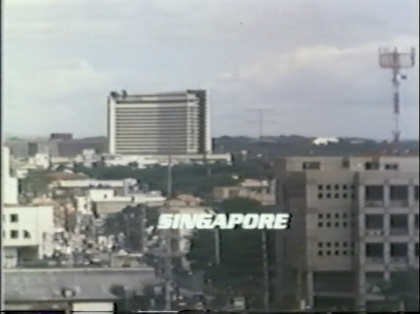
(3)

(4)
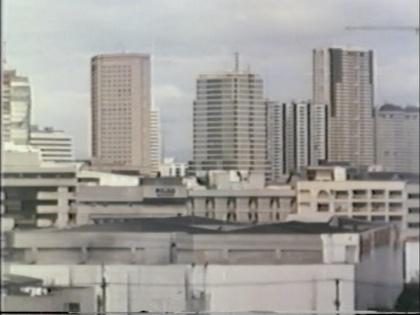
(5)

Taken from the film…
Filed under: postcards
May 4, 2009
Araya Rasdjarmrearnsook
(1)
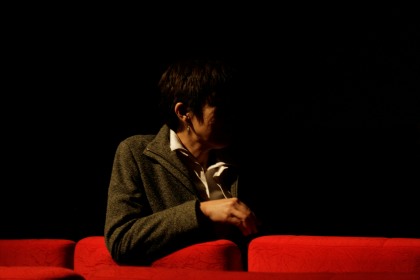
(2)

Filed under: philippine cinema



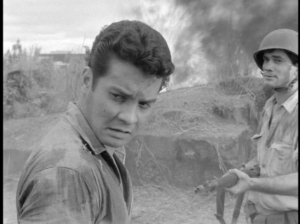
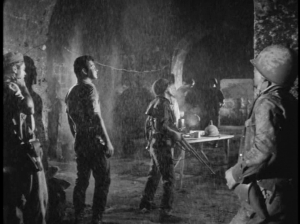


The World War II film Intramuros aka Walls of Hell (1964), boasts a shared director credit by two Filipino National Artists, Gerardo De Leon and Eddie Romero, but of greater interest to me was another aspect of it: the early, iconic performance in it by Philippine action star Fernando Poe Jr (aka FPJ).
Poe, appearing to deliver his own lines (I’ve not verified this), speaks English with a thick – but by no means awkward – accent, and his character exudes an aura of invincibility, even when in a vulnerable position (as in the first shots above, when surrounded as he exits a manhole). Watching him in Walls of Hell reminded me of Robert Duvall’s Captain Kilgore in Apocalypse Now: while Poe’s character is a realist and Duvall’s an eccentric, they share a similar level of superhuman confidence, one almost attaining physical property; intimating that the circumstances in which they existed (– war) served them no threat.
A.H. Weiler, a critic at the NY TIMES reviewing the film in 1965, described Poe as “laconic, serious and muscular”, and his character as “the handsome Filipino who insists that the captives be freed before the walls are breached.” The name of Poe’s character: Sgt. Leonardo Maglaya.
My father’s name is Leonardo, and he was a huge fan of FPJ. If it wasn’t for this fact I might not have been so enraptured by Poe’s performance in the film, nor been as interested in him and his other important performances (including this one, as a schoolteacher turned rebel, in Celso Ad Castillo’s Asedillo). What kind of Poe fan was my father? Not crazy enough to have voted for the action star when he ran for President, but serious enough to have attempted, despite recovering from surgery and with Doctor’s orders to avoid public spaces, to pay his respects to the fallen actor at his wake (one among throngs in the thousands, he didn’t get anywhere near the coffin where Poe’s body lied). He enjoyed target shooting, my father, was a champion when he was young, and never failed to light up with a smile, laughing as he explained Poe’s style of gun-slinging in films, knowing as he did how improbable it was in real life.
Like Poe’s Leonardo, my father often exuded, at least to me and my siblings, a similar sheen of invincibility: a stature and confidence that made you believe he could survive anything. Though thinking about it now, his was perhaps an emotional strength much more than a physical one, which lead us to take for granted, even when he was hospitalized regularly and enduring a siege of problems and responsibilities, that these too would be but passing threats…
He passed away three years to this day. However inadequate a remembrance, this post is dedicated to his memory.
Filed under: Updates
A blog for the series of screenings held in the book shop Fully Booked, in Fort Bonifacio, Taguig: http://fullybookedfilmseries.wordpress.com/
Have a look and if you are or will be in Manila, please come. Screenings updates will be posted there, as well as notes on past screenings (introduction by the filmmakers, or links to relevant info).
Filed under: quotes
From Chain of Dreams by Tag Gallagher:
What interested him most about making movies, said Carl Th. Dreyer a few years before his death, was to “reproduce the feelings of the characters in my films […], to seize […] the thoughts that are behind the words […], the secrets that lie in the depths of their soul”.
“Gertrud [1964] is a film I made with my heart”, he added. With the heart. About the heart. “What interests me before all, it’s this, and not the technique of cinema.”
Technique, nonetheless, is the tool the heart must use. Accordingly, Dreyer mobilizes all cinema for the hunt. “I need a big screen”, he said. “I need the communal feeling of a theater. Something made to move has to move a crowd.” He wanted to do Gertrud in colour. Maybe 70mm, too, like Lawrence of Arabia (David Lean, 1962). Isn’t Lawrence (Peter O’Toole) on a camel in a desert like Gertrud (Nina Pens Rode) on a seat in a parlour? Dreyer wanted mass catharsis, the way Greek theatre did, or maybe the way college basketball does, with thousands of pulses synched to that ball’s movements. With the result that Gertrud is more like a basketball game than Lawrence, has more action, excitement, spills, chills and thrills, and has some of the “coolest” scenes in movies, piled on top of each other.
Curious it is, then, that some people complain Dreyer is slow and intellectual, talkie and dull, Gertrud particularly. They never spot the ball. As a result, it is unlikely in my lifetime that I shall share Gertrud on a big screen with two thousand pulses synched to her every movement. Like most people, I shall see Gertrud at home alone, on my television, and even with a large screen and Criterion’s excellent DVD, I shall have to press my player’s zoom button in order to see into her eyes. She and her men sit in full-length compositions like figures in gigantic tapestries. “I don’t like television”, Dreyer said.
Gallagher is a fantastic critic that deserves much more credit. More of his writing is available on his website, including (quite generously) downloadable pdf files of his 884 page tome on Rossellini (“The Adventures of Roberto Rossellini”) and his tome on John Ford (“John Ford: The Man and his Films”, revised in 2007 and with frame enlargements).
During the 1982 Cannes Film Festival, [Wim] Wenders asks a number of film directors from around the world to get, each one at a time, into a hotel room, turn on the camera and sound recorder, and, in solitude, answer a simple question: “What is the future of cinema?” (from imdb)
Among Wenders’ esteemed respondents: Jean-Luc Godard, Rainer Werner Fassbinder, Michelangelo Antonioni, Werner Herzog, Chantal Akerman, Steven Spielberg, Robert Kramer, and, one of the finest filmmakers (italics intentional) ever to come from the Philippines, Mike De Leon, who had not one but two films (Kisapmata and Batch ’81) in the Director’s Fortnight section that year.
De Leon sits — one leg resting on the other, cigarette dangling from a relaxed hand, television running to his side running — unphased by the reputations of his co-respondents and without impulse to impress, gives his answer; brief, to the point, and sans any BS:
You gotta leave the nonchalance.
More De Leon, this time on the reception of the two films in Cannes:
The French preferred Kisapmata to Batch ’81. According to some of them it was not just because fraternities of that sort were alien to them (the French are basically individualists). Pierre-Henri Deleau had predicted, after seeing the rushes here, that the French would be outraged by Batch. The English and the Americans gave it a better reception in Cannes. But it wasn’t just a matter of theme but of story-telling method. While Kisapmata‘s method was closer to the French, Batch was more in the American manner.
After the first screening, animated discussion went on and there were two sides debating whether the film was fascist or anti-fascist. Apparently the ending was ambiguos. I said that there are graduation rites, in fact. I felt that I had made it clear that Mark Gil’s character at the end was . . . hindi na tao. That is why that martial law line was important because it situates the film. It was supposed to be clear that the film was making a comment on organizations of a fascist nature, that this is what can happen to individuals who join such an organization. But it appears that although I felt it was the same thing with Kisapmata, Kisapmata was clearer if one removes the ethnic-ness of the characters, it would happen anywhere, in the suburbs of Paris or what.
After the fourth screening, there was a demand to give another screening, but it was too expensive. There was this vague feeling about Batch; at the end of the film, there was first a momentary silence, and only afterwards, some applause. I suppose it’s the construction and the editing, which is more American. I call it “neurotic editing” — I felt like I couldn’t wait to cut it to get to the next part. My idea for Batch, let’s say, was more of accumulation, dagdag nang dagdag, instead of a gradual progression, and that doesn’t go well with the French.
(Well, I just heard from Tony Rayns that it had a much better reception recently in London. I suppose, as indicated by the English film If, this strict, authoritarian, discipline-oriented organization is closer to the English system than to the French).
[From: “The A.K.O. Story” by Petronilo G. Cleto, published in WHO magazine, Dec.15, 1982.
Reprinted in the magazine of the (then) Film Ratings Board, Filipino Film Review, January 1983]
* With thanks to Teddy Co.
(Shorter version originally published as an addendum to an article in Rogue Magazine, extended final version which appears below published in Philippines Free Press week of December 13, 2008).
Wishful Thinking for Philippine Cinema
By Alexis A. Tioseco
I wish that the Film Development Council of the Philippines would understand the value of the money they’re given and consider going to Paris and spending P5 million of their P25 million allotment for a showcase given by a young festival an investment, and not just a vacation.
They support filmmakers with finished films to go abroad to festivals for the pride they bring their country—I wish instead they would support their films locally, and help them get seen by a larger Filipino audience.
I cry for the loss of Manuel Conde’s Juan Tamad films.
I cry for a country that can’t convince that one Filipino-American who owns the only known print of Conde’s Genghis Khan in its original language to return (i.e. sell) the film back to his mother country.
I cry for the generations of Filipinos, myself included, that can no longer see Gerry De Leon’s Daigdig ng Mga Api, and instead have scans of movie ads to admire on the internet (with sincere thanks to Simon Santos and James De la Rosa).
I mourn a heritage that has allowed through neglect the prints of Mario O’Hara’s Tatlong Taong Walang Diyos and Peque Gallaga’s Oro, Plata, Mata to turn flush sepia.
I cry for a Union Bank and University of the Philippines that conspire in apathy to let the master negatives of treasures produced by Bancom Audiovision rot in rooms only air-conditioned half the day and in cans untouched for years and years.
I pray for a city government or even enterprising and concerned theater owners to consider setting aside 50 centavos or a peso of a ticket for the preservation of our national audiovisual heritage. There have been flood taxes siphoned from movie tickets for crying out loud—this should be easy!
I wish Cinemalaya, which, thanks to the media and the government’s press mileage behind it, has a great festive excitement, would actually put their efforts in the service of Philippine cinema, and not their own self-involved attempt to start a micro-industry.
I wish filmmakers would stop listening to Robbie Tan.
I wish Cinema One, which takes more risks, gives more money and often produces better films than Cinemalaya, would actually give filmmakers some rights to their work and stop swindling them.
I wish Cinemanila, which has introduced to the country more great films than any other institution, doesn’t stop showing them on 35mm.
I wish Cinemanila would publish their full schedule in advance: it’s difficult to plot what films to watch when you don’t know which ones will show again.
I wish the Goethe- initiated Silent Film Festival, with live scores by Filipino musicians, would continue annually, and that one year they get to show a Chaplin, a Griffith, a Dreyer, and maybe a Vertov or Medvedkin.
I wish Lav Diaz would have larger budgets to maneuver and shoot with. And would work with the ace production designer Cesar Hernando once again.
I wish more people saw Lav Diaz’s films rather than just respecting his stance, and using him as a symbol.
I wish Raymond Red would get to make Makapili and/or return to making fantastic shorts in the experimental mode.
I wish Raymond Red would still get to shoot on celluloid.
I wish John Torres would sacrifice the image quality of his HDV camera for the special intimacy and spontaneity he is able to achieve with his 1ccd camera. Or get a smaller HDV camera.
I wish Mike De Leon would make another movie… please.
I wish Roxlee would get enough money to buy the time necessary to make an animated feature.
I wish everyone would buy a copy of Nicanor Tiongson and Cesar Hernando’s richly illustrated The Cinema of Manuel Conde.
I wish there were more books on Philippine cinema.
I wish a book series was started that published classic screenplays.
I hope Noel Vera gets to write his book on Mario O’Hara.
I wish a close study of the entire oeuvre of Ishmael Bernal were made.
I wish older commentators would understand: Lino Brocka is dead.
I wish younger filmmakers would understand: Lino Brocka compromised when he had to because he had to, and perhaps even, at times, too much. You are living in a different time. The excuse that Brocka made more than 60 films therefore you can afford your own mediocre ones does not hold water.
I wish we had less tourist cinema.
I wish we had less formula cinema—“real-time” anyone?
I wish Cinefilipino had put out Maalaala Mo Kaya with the reels in the proper order.
I wish Cinefilipino would have put our their Brocka titles with just a little bit of care and affection, providing some writing on the film or special features to contextualize them rather than just throw them out their bare to earn.
I wish Nestor Torre would open his eyes…
I wish the Manunuri books on Philippine cinema in the’70s and’80s would go back in print.
I wish the Manunuri actually cared about Philippine cinema today.
I wish more of the Manunuri actually reviewed films instead of just giving out awards.
I wish the Young Critics Circle were actually young.
I wish the Young Critics Circle were actually critics.
I wish Francis ‘Oggs’ Cruz, Richard Bolisay, and Dodo Dayao would get space in the broadsheets, because they’re far more interesting than anyone writing there regularly.
I wish we didn’t have a cinema of the press (more on this soon).
I wish Noel Vera would move back.
I wish Hammy Sotto were still alive.
I wish Hammy Sotto’s manuscripts would get published.
I wish film preservation activist Jo Atienza was still in Manila.
I wish we had a fully supported Film Museum.
I wish we had a Cinematheque.
I wish the UP Film Center had better seats, and more important, showed better films.
I wish more non-filmmakers from the Philippines would get to travel to festivals.
I wish film were taught in high schools.
I wish we had more film lovers and less bureaucrats in important positions in the field of cinema.
I wish Teddy Co would get the recognition that he deserves for his selfless work.
I wish Teddy Co would write more as his ideas deserve to be recorded.
I wish co-ops would co-operate.
I wish Khavn De La Cruz would get to make his musical EDSA XXX.
I wish the Max Santiago feature would get made, and that shorts would finally come to my hands on DVD (Hi Marla!).
I hope Tad Ermitano never stops writing and playing in his cave.
I wish Lourd De Veyra would continue writing on actors and cinema.
I wish Raymond Lee’s UFO success.
I wish Albert Banzon would get more credit.
I wish we had more regional feature films, and more support for regional filmmakers.
I wish everyone would watch When Timawa Meets Delgado.
I wish someone would lower MTRCB rates for screening fees, especially for festivals.
I wish someone, anyone, would make a good, thought-provoking film about the Philippine upper class.
I wish Ketchup Eusebio would get more leading roles.
I wish Elijah Castillo would appear in a lot more films. Soon.
I wish Cesar Hernando would get to make a video transfer of his experimental short Botika, Bituka.
I wish filmmakers had some integrity and told Viva to screw themselves when offered another exploitation film.
I wish more people could see the film Bontoc Eulogy by Marlon Fuentes.
I wish Vic Del Rosario wasn’t presidential adviser on Entertainment, given the shlock they produce, and yes, that includes the films that starred First-Son Mikey Arroyo.
I wish Star Cinema would stop—just stop.
I wish there was a film library that people could go to in order to read books on cinema.
I wish the MMFF were not in the hands of the same people who install public urinals (admittedly useful).
I wish the MMDA didn’t call those circles and boxes Art.
I wish that MMDA Art wasn’t so much better than every MMFF film.
I wish a certain festival in December didn’t consider box office as a criteria for its main prize (which comes with rewards). We don’t give cultural awards to Wowowee, do we? Well, not yet…
I wish I could see how “commercial viability” was computed.
I wish Mother Lily didn’t have a monopoly on the Metro Manila Film Festival.
I wish Mother Lily took better care, or rather took care at all, of the good films she unwittingly produced in the past.
I wish Mother Lily would get to see Raya’s Long Live Philippine Cinema! …or maybe not.
I wish the Hammy Sotto-led Philippine Cinema in the ’90s book, with excellent interviews and a complete filmography of the decade, and which has been completed for several years, would finally get printed.
I wish all the old Mowelfund shorts—including the works of Regiben Romana, the Alcazaren Brothers, Louie Quirino and Donna Sales, Raymond Red and Noel Lim—would come out on DVD.
I wish a book would be written about all the Mowelfund shorts.
I wish a book on Philippine poster art would be released.
I always look forward to the rest of Nick Deocampo’s projected four-to-five volume history on Philippine cinema—at least someone is writing it.
I wish there were a pure film studies course available in the Philippines.
I wish that venues that are censorship (and therefore MTRCB fee) exempt would understand the vital role they play and take more responsibility.
I wish we had a regular film journal. Why don’t we? We have enough critics groups and awarding bodies.
I wish more film teachers were approaching cinema from cinema.
I wish R.A. Rivera would get to make his first feature soon.
I wish Quark Henares refrains from selling out again, because if he doesn’t, he has the potential to be one of the important ones.
I wish more people would get to see In Da Red Korner. It deserves to be reconsidered.
I wish Rogue Magazine would cut down their featuring of foreign films in the gallery section when there is so much to write about locally that doesn’t get covered in other media beyond sloppy journalism.
I wish the government would sponsor DVD releases of the surviving films of Lamberto Avellana, Gerardo De Leon and all other classics that still exist.
I wish FPJ Productions would again screen the footage of Gerry De Leon’s unfinished Juan de la Cruz (the icon, by the way, that was invented by this magazine).
I wish less filmmakers compromised.
I wish more filmmakers admitted when they did.
I wish we focused our attention more on audience education, development and literacy, than on dumbing down films to pander to them.
I wish Philippine cinema all the success in the world. . .
Filed under: philippine cinema
Since I started writing fairly regularly for Philippines Free Press late last year, I’ve began to be of two minds about the importance of film journalism as opposed to film criticism in the Philippine setting. A local independent filmmaker whose films don’t do much for me once chastised me saying that I “should be documenting more what’s happening in the scene”, and that “yes, the filmmakers you’ve blessed [by this I believe he meant written about] are getting attention internationally, but what about the rest?”. I responded, with a degree of indignation, no doubt tinged by the ridiculous use of the word “blessed”, by saying that there were broadly speaking three types of writing on film in the Philippines: reporting, journalism, and criticism. The first simply announces what has happened (“film x won an award in a Marine Film Festival!”), the second, at least in our local context, will do the same but perhaps include some minor additional research or a quote (“film x won an award in an Marine Film Festival, the first and only Marine festival in Asia. the director had this to say about the experience “[insert quote gushing with pride]”, the third, which I claimed for myself at the time, was the space of criticism, which I said was attempting to discuss the films themselves as works of art, and championed the need for this kind of writing on cinema in the Philippines given how little of it there was here.
As I’ve attempted to write criticism on a more frequent basis, I’ve come to realize the importance of good film journalism as a starting point on which criticism can stand. Without intelligent film journalism being written, each piece of criticism will almost necessitate a degree of greater contextualization before the criticism proper can begin; something extremely difficult to do especially when space is limited. Do we have good film journalism in the Philippines? I don’t think anyone of half a mind would say yes without twitching. Under the classification of reporting and journalism there are a host of familiar names of varying, often diminishing, levels of quality: Ruben Nepales, Marinel Cruz, Bayani San Diego, sometimes filmmakers like Rica Arevalo, and worse, old timers like Nestor Torre who writes mostly about things he has a vested interest in — (count the number of articles he’s written about Cinemalaya vs. Cinema One Originals to verify this). And this is just the staff of one newspaper. Proof of the problem? How are audiences to understand the value of a particular recognition bestowed upon a film for example, when you have news of Lav Diaz’s Death in the Land of Encantos or Melancholia winning prizes in the Orizzonti section of the prestigious Venice Film Festival receiving less space and attention than Adolf Alix Jr.’s Donsol winning in an Asian Marine Film Festival? This is a problem, and to the innocent reader it can be very misleading. What we have, ultimately, is a cinema of the press, where reporters and journalists rarely seek out stories or are discerning in their coverage, instead using what’s handed to them. A virtual competition for number of free printed press releases ensues, which only encourages filmmakers to put more effort into their PR than they do to their pre-production.
If I was in another country with a healthier quality of film journalism I probably wouldn’t think twice about the choice between the two. I enjoy more and find more challenging the writing of criticism. I learn more from it. But I’m beginning to feel the need for intelligent, informed film journalism, and am beginning to feel some responsibility to write it. To follow are a few more journalistic pieces written for Philippines Free Press and elsewhere.
A side note — a few local writers on cinema worth reading:
Richard Bolisay (Lilok Pelikula)
Francis Oggs Cruz (Lessons from the School of Inattention)
Dodo Dayao (Piling Piling Pelikula)
On his blog Noel Vera recently mentioned my writing on local cinema being increasingly infrequent (I would link what he wrote but it included a highly slanderous remark!). It hasn’t been, I’ve actually been writing more frequently than usual, just less of it has appeared online. So for Noel if no one else I’ll post them here slowly.
To start, two articles I wrote for the local magazine Rogue have been published online.
(1) The Letter I Would Love To Read To You In Person (Column)
(2) When Timawa Meets Delgado (Review)
The first is written in the form of a letter, and was the article submitted when commissioned to write about my work in relation to Philippine cinema. It ends with a bit of a litany (according to Teddy Co), on numerous issues in Philippine cinema. An expanded version of this addendum was published in the Philippines Free Press, and I’ll post that version shortly.
The second is a review of the film When Timawa Meets Delgado by Ray Defante Gibraltar (he of the fantastic name), one of the best and most original Filipino films of the past few years. The title used for the article (Nursery Rhyme) wasn’t mine, and the instructions I gave for the use of stills (and effort I put to select and capture them all) in the printed version were not followed. But so it goes…
Articles have been added to the texts online section of this blog. More articles, this time ones written for the Philippines Free Press, to follow…
Two from Forum Lenteng. Jakarta, July 2008:


Three from Rumah Buku. Bandung, July 2008:



Was invited by HarryTuttle to participate in an e-mail round table discussion together with himself and a few other online writers (Kevin Lee, Andrew Grant, Nitesh Rohit and Edwin Mak) over at The Auteurs Notebook. My two contributions:
In the second I touch on the images featured above, which I took in Indonesia this past July.
(1)

(2)
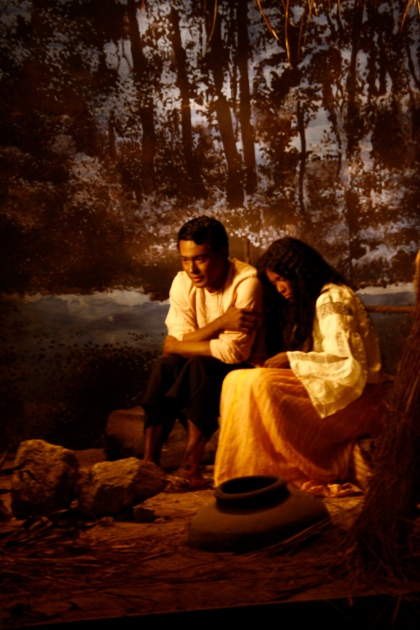
(3)
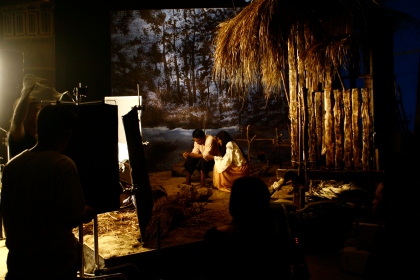
(4)
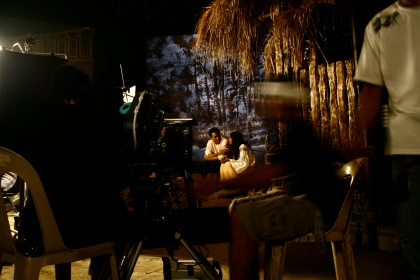
(5)

—
Images from the set of Raya Martin’s Independencia, Monday December 15. Shooting day number 8 of a 15 day straight shooting schedule. While I preserved the color of the images I took, the film is being shot in black and white.
Independencia is the second part of a trilogy that began with Maicling Pelicula Nang Ysang Indio Nacional (O Ang Mahabang Kalungkutan ng Katagalugan) (A Short Film About the Indio Nacional (Or the Prolonged Sorrow of the Filipinos, 2005) and takes place during major periods of struggle in Philippine history. It continues the aesthetic design for the trilogy started by Indio Nacional, which is for each film to mimmick the cinematic style of the era and culture it depicts. For Indio Nacional which took place at the end of the Spanish occupation of the Philippines, that meant shooting in the vain of the silent-film, with a static camera, intertitles, and simple animation, for Independencia, set during the American occupation, it means shooting entirely in a studio, utilizing artificial backdrops, and applying heavy make-up on the actors. Seen in the images above is one of painted backdrops for the film. There are between fifteen and twenty of them in all.
Cinematographer for the film, being shot on black and white 35mm stock, is Jeanne Lapoire, who has worked with the likes of Francos Ozon, André Téchiné and Pedro Costa (for the Straub film), among others. Her full credits can be viewed here.
The actors in the images above are Sid Lucero and Alessandra De Rossi.
The film is to be edited by Lav Diaz.
[Update April 26, 2009: Lav Diaz was no longer the final editor of the film. The credit belongs to Jay Halili]
* outtake after the cut

